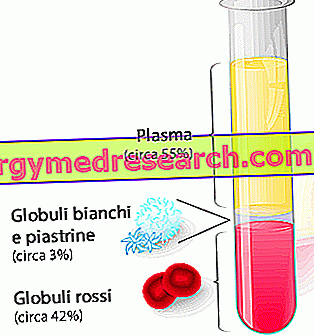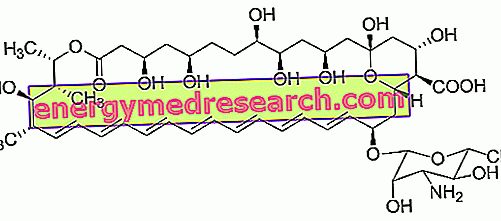Generality
The anus is the external opening that marks the end of the gastrointestinal tract and that allows the human being to eliminate the feces.
According to some anatomy experts, the anus would also include the anal canal of the rectum. The rectum is the last part of the large intestine.
Located in the perineum, about 3 centimeters ahead of the coccyx, the anus has an internal anatomy which includes: an epithelium similar to that of the skin (but without hair and sebaceous and sweat glands) and two circular muscles, known as anal sphincter internal and external anal sphincter.
The internal anal sphincter and the external anal sphincter are fundamental in the process of defecation, ie the process of emission of fecal material.
Different pathologies and disorders can affect the anus and the anal canal of the rectum. The most common diseases and anal disorders include: hemorrhoids, anal itching and anal fissure.

What is the anus?
The anus is the external opening at which the gastrointestinal tract ends.
To be precise, it is the external opening that marks the end of the anal canal of the rectum, or the terminal portion of the intestine .
In anatomy, external openings such as the anus are also known as " orifices " (singular "orifice").
OTHER DEFINITION OF ANO
Some books on human anatomy treat the anus as the region of the gastrointestinal tract that includes the anal canal of the rectum and the external opening that marks the end of this canal.
In simpler words, the anus includes the anal canal of the rectum with its orifice towards the outside.
WHAT IS THE RIGHT?
The rectum is the terminal tract of the large intestine or large intestine .
About 13-15 centimeters long and surrounded by different muscles and ligaments of the pelvic floor, the human rectum connects the colon-sigma intestinal tract with the anus.

Figure: portions of the large intestine.

Figure: anus and rectal canal.
In general, the anatomists divide the rectum into two portions: a pelvic portion and an anal (or perineal ) portion .
Located in the pelvis, the pelvic portion represents the first portion of the rectum and includes a region called the rectal ampulla .
The rectal ampoule is used to receive the stools ready for elimination and has considerable expansion capacity.
The anal portion constitutes the second portion of the rectum and substantially corresponds to the aforementioned anal canal . Projecting in a posterior direction, the anal canal forms an angle of almost 90 ° with the pelvic portion and has an average length of about 3-4 centimeters.
Anatomy
The anus resides in an anatomical region known as the posterior perineum, about 3 centimeters ahead of the coccyx, at the bottom of the groove between the two buttocks .
In resting conditions, its external appearance resembles that of a fissure with ruffled edges, bounded by two lateral lips.
Always remaining outside the anus, numerous sweat glands, sebaceous glands and hair follicles are located around the orifice.
It is important to point out that the presence of hair at anal level is typical of man and rare in women.
Internally, the anus has a squamous epithelium, similar to the skin but without hair, sebaceous glands and sweat glands.
Proceeding towards the rectum (to be precise towards the rectal canal), it is possible to recognize a particular circular area, which the anatomists call the combed line (or dentate line ). The combed line substantially marks the point where the mucous membrane typical of the rectal tract ends and the point where the aforementioned cutaneous-like squamous epithelium begins.
In correspondence of the worsted line, they locate important anatomical structures, known as columns of Morgagni .
Around the skin-like squamous epithelium and partly also around the rectal canal mucosa, two important circular muscles take place: the smooth anal sphincter (or internal anal sphincter) and the striated anal sphincter (or external anal sphincter).
INTERNAL ANAL SPOINTERS
Formed by smooth muscles, the internal anal sphincter represents the thickened continuation of the smooth muscles surrounding the rectum.
It works involuntarily (like all smooth muscles) and is important, but not essential, for continence of faeces (fecal continence).
EXTERNAL ANAL SPINNER
Formed by striated musculature, the external anal sphincter resides all around the internal anal sphincter.
It works on a voluntary basis (like all striated muscles), represents a continuation of the levator ani muscle and is fundamental for continence of feces.
BLOOD SPRAYING
To supply oxygenated blood to the anus and neighboring regions (such as the anal canal) are the superior haemorrhoidal artery (which is a branch of the inferior mesenteric artery), the medial haemorrhoidal artery (which originates from the hypogastric artery) and the lower hemorrhoidal artery (which derives from the internal pudenda).
The drainage of venous blood, devoid of oxygen, involves the internal hemorrhoidal plexus and the external hemorrhoidal plexus . The internal haemorrhoidal plexus drains into the upper rectal veins, which in turn pour the blood content into the inferior mesenteric vein. The external hemorrhoidal plexus, instead, drains into the middle rectal vein and into the pudenda vein, which then flow into the internal iliac vein.
INNERVATION
The nerves that innervate the anus and adjacent areas come from the so-called superficial perineal nerve, which in turn derives from the pudendal nerve .
LYMPHATIC DRAINAGE
The lymphatic vessels of the anus and surrounding area drain their contents into the superficial inguinal lymph nodes .
Functions
The anus is the opening through which the human being eliminates feces during the act of defecation .
Defecation - the process of emission of fecal material - is a physiological reflex, which results from intestinal peristalsis .
The internal anal sphincter and the external anal sphincter muscle play a fundamental role in eliminating stools.
Both allow the emission of fecal material when they are relaxed.
The internal anal sphincter relaxes involuntarily, in response to the pressure exerted by the feces that reach the rectum (precisely in the rectal ampulla).
The external anal sphincter, on the other hand, relaxes based on a voluntary stimulus of the subject in need of defecation.
It is important to point out that the elevation muscle of the anus also participates in the defecation process, supporting the anal sphincters in their action.
To learn more about defecation, readers can click here for a dedicated article.
Control of the external anal sphincter
The human being controls the external anal sphincter starting from 3 years of life . This explains why children under the age of 3 lose their feces without realizing it.
In a later phase of life and following particular pathological conditions, the control of the external anal sphincter can be lost.
Among the main conditions that can lead to a loss of control of the external anal sphincter, deserve a mention: the neurological syndromes and the forms of dementia .
Illnesses
Different pathological conditions of varying severity can affect the anus and the rectal canal.
Among these conditions, the best known and most common are:
- Hemorrhoids . In anatomy, the term "haemorrhoids" identifies soft and very vascularized pads, located in the terminal part of the rectum.
In medical pathology, instead, it identifies a morbid condition in the presence of which these pads dilate and slide downwards, following a failure of the rectal mucosa.
Doctors classify hemorrhoids as a disease in two ways: internal hemorrhoids and external hemorrhoids.
In those suffering from internal hemorrhoids, the hemorrhoids (intended as an anatomical region) glide down to the anal canal of the rectum, without becoming visible to the naked eye.
In those who suffer from external hemorrhoids, however, they slip up to the anal opening and are generally well visible from the outside.
Readers intending to investigate this topic can consult the article here.
- Anal abscess (or perianal abscess ). It is a collection of pus, located near the anus or rectum, on a superficial level. It is generally the fruit of an infectious process, which concerns the glands of the anal region.
For more information, readers can click here.
- Anal itching . It is a very frequent condition and generally not dangerous.
Readers interested in exploring this topic can consult the articles here (for the definition), here (for the remedies), here (for the causes and symptoms) and here (for the drugs).
- Anal herpes . It is a viral infection due to the herpes simplex 1 and herpes simplex 2 viruses.
Determines the appearance of painful blisters in the anal region.
To learn more about herpes simplex viruses, we recommend the article here on genital herpes.
- Anal warts . They are cutaneous protuberances of variable dimensions, located near the anus. Generally, they are the result of human papilloma virus (HPV) infections.
They produce pain and bleeding.
- Anal fissure . It is a small cut, which the anal opening develops as a result of excessive dilation, during the passage of the faeces.
This disorder is particularly irritating and painful, as the anus and the anal region in general are rich in nerve endings.
To know the causes of anal fissure, readers can consult the article here.
- Anal bleeding . The loss of blood from the anus is generally a symptom of hemorrhoids and anal fissure.
More rarely, it is the manifestation of morbid states such as colorectal polyps, colorectal carcinoma, diverticulitis or ulcerative colitis.
For more information on this, we advise the reader to read the article here: the theme is "blood in toilet paper".
- Constipation (or constipation) . It is the difficulty of defecation. It can cause anal pain, anal fissure, stomach pain, swelling in the anal area, etc.
For more information on this, readers can click here (by definition of constipation), here (for a list of symptoms), here (for an anti-constipation diet) and here (for drugs).
- The tumor of the anus . It is a very rare neoplasm, which affects about 1-3 individuals per 100, 000 people.
According to some studies, they would seem to favor its appearance: human papilloma virus (HPV) infection, anal sex, cigarette smoking, a condition of depression of the immune system (immunodepression) and a clinical history of frequent benign anus lesions and / or rectum (warts, hemorrhoids and abscesses).



